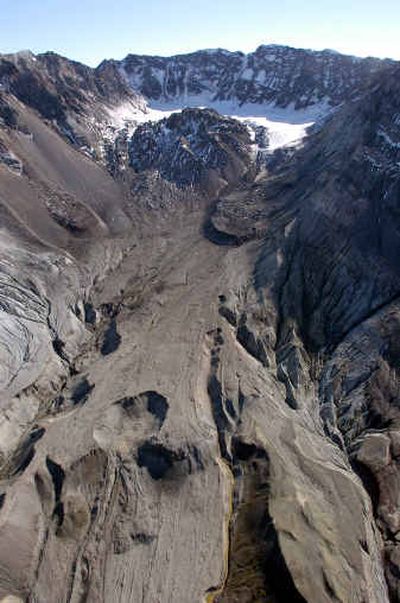Volcano eruption warning raised

SEATTLE – Mount St. Helens began rumbling more intensely Wednesday, prompting scientists to raise the eruption warning level and suggest that ash and rock from a blast could land as far as three miles from the volcano’s crater.
Earthquakes ranging from magnitude 2 to 2.8 were coming about four times a minute, possibly weakening the lava dome in the crater of the 8,364-foot mountain, the U.S. Geological Survey said.
Scientists did not expect anything like the mountain’s devastating eruption in 1980, which killed 57 people and coated towns 250 miles away with ash. But a small or moderate blast could come in the next few days, they said.
“We’re in a position right now where we could have a small event to a moderate event happening without any warning,” USGS seismologist Cynthia Gardner said.
They raised the mountain’s eruption advisory from the second level – “volcanic unrest” – to the third level – “volcano advisory” – out of four, which means the USGS began notifying more state and federal agencies of a possible eruption, though no human life appeared to be threatened. The USGS asked the National Weather Service to be ready to track an ash plume using its radar system.
In addition, scientists called off a plan to have two researchers from the Geological Survey’s Menlo Park, Calif., office study water rushing from the crater’s north face for signs of magma.
A plane still flew over the crater Wednesday to collect gas samples, however. The scientists on board found negligible amounts of volcanic gas, but another flight was planned within the next few days to continue monitoring.
“An aircraft can move the hell out of the way fast,” said Jeff Wynn, the chief scientist at the survey’s Cascade Volcano Observatory. “We don’t want anyone in there on foot.”
The closest structure to the volcano is the Johnston Ridge Observatory, about five miles from the crater.
Scientists have been monitoring St. Helens closely since last Thursday, when swarms of tiny earthquakes were first recorded at the southwest Washington mountain, and on Sunday they issued a notice of volcanic unrest, closing the crater and upper flanks of the volcano to hikers and climbers. Few people live near the mountain, which is surrounded by a national monument and a national forest.
The scientists said Wednesday they believe the seismic activity is being caused by pressure from a reservoir of molten rock a little more than a mile below the crater. That magma apparently rose from a depth of about six miles in 1998, but never reached the surface, Wynn said.
Since last week, scientists have also observed a slight northward movement – about an inch and a half – of the 925-foot-tall dome of hardened lava that grew inside the crater from 1980 to 1986.
The mountain’s eruption on May 18, 1980, blasted away its top 1,300 feet, spawned mudflows that choked the Columbia River shipping channel, leveled hundreds of square miles of forests and paralyzed towns and cities more than 250 miles to the east with volcanic ash.